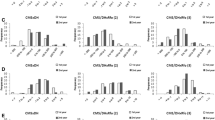Summary
Three unrelated pairs of inbred lines from marrow-stem kale (A), thousand headed kale (B), and Scotch curled kale (C), together with 3 lines from Chou Fourrager Jaune (D), Brussels sprouts (E), and January King cabbage (F) were used to produce a diallel cross.
Study of the F1 generation revealed that general combining ability was highly significant for all yield components studied and specific combining ability was also significant for all but at a much lower level. Greater heterosis for leaf yield, but not for stem yield, was indicated in the inter-type hybrids as compared with intra-type hybrids.
Double-crosses made among F1 from the paired inbred lines did not reveal consistent effects of order of combining the inbred lines on yield characters, but the large differences in plant-to-plant uniformity showed that only the (X1×X2)×(Y1×Y2) combination is likely to be of practical significance.
Similar content being viewed by others

References
Anderson D. C., 1938. The relation between single and double-cross yields in corn. J. Am. Soc. Agron. 30: 209–211.
Doxtator C. W. and Johnson I. J., 1936. Prediction of double-cross yields in corn. J. Am. Soc. Agron. 28: 460–462.
Eckhardt R. C. and Bryan A. A., 1940a. Effect of the method of combining the four inbred lines of a double cross of maize upon the yield and variability of the resulting hybrid. J. Am. Soc. Agron. 32: 347–353.
Eckhardt R. C. and Bryan A. a., 1940b. Effect of the method of combining two early and two late inbred lines of corn upon the yield and variability of the resulting double crosses. J. Am. Soc. Agron. 32: 645–656.
Griffing B., 1956. Concept of general and specific combining ability in relation to diallel crossing systems. Aust. J. biol. Sci. 9: 463–493.
Hayman B. I., 1954. The theory and analysis of diallel crossing, Genetics N. Y. 39: 789–809.
Jenkins M. T., 1934. Methods of estimating the performance of double crosses in corn. J. Am. Soc. Agron. 26: 199–204.
Johnson, A. G. and Faulkner, G. J., 1963. A. Rep. natn Veg. Res. Stn (1962): 20.
Johnston T. D., 1963. Inbreeding and hybrid production in marrow-stem kale (Brassica oleracea L. var. acephala D. C.). I. The effects of inbreeding and the performance of F1 hybrids. Euphytica 12: 198–204.
Johnston T. D., 1964. Inbreeding and hybrid production in marrow-stem kale (Brassica oleracea L. var. acephala D.C.). II. The prediction of double-cross performance. Euphytica 13: 147–152.
Thompson K. F., 1964. Triple-cross hybrid kale. Euphytica 13: 173–177.
Thompson K. F. and Taylor J. P., 1966a. Non-linear dominance relationships between S alleles. Heredity, Lond. 21: 345–362.
Thompson K. F. and Taylor J. P., 1966b. The breakdown of self-incompatibility in cultivars of Brassica oleracea. Heredity, Lond. 21: 637–648.
Author information
Authors and Affiliations
Rights and permissions
About this article
Cite this article
Johnston, T.D. Studies on a diallel cross and double-cross hybrids among various Brassica oleracea types. Euphytica 17, 63–73 (1968). https://doi.org/10.1007/BF00038967
Received:
Issue Date:
DOI: https://doi.org/10.1007/BF00038967



